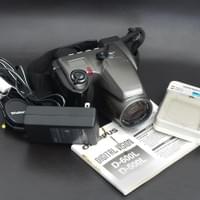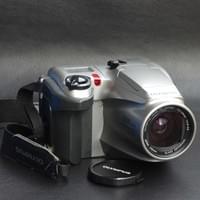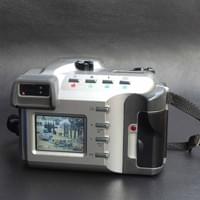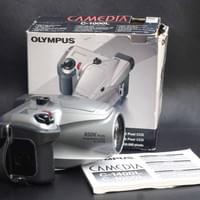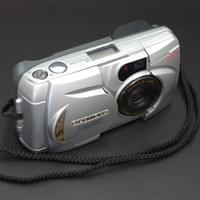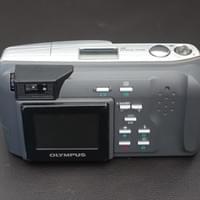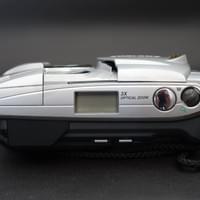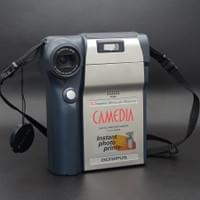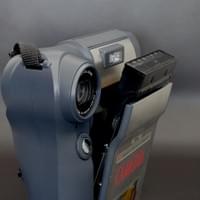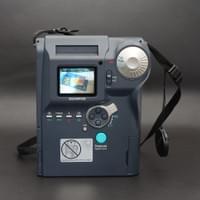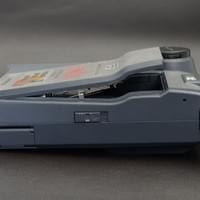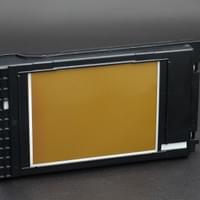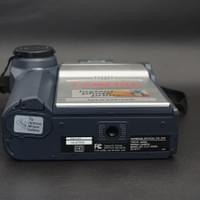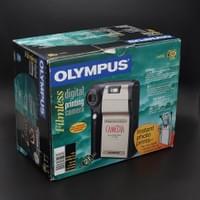
Olympus C-400 (1996)
You could say it’s what’s missing from this camera that now makes it a rarity.
The C-400 was the base-level model of three cameras that marked the entry by Olympus into the consumer digital era
in 1996.They were the first Camedia cameras.
The others were the higher-spec C-400L and the C-800L – the L indicating the presence of an LCD screen.
The C-400 had no screen and a tiny 1mb of internal memory. My guess is that consumers asked themselves “What’s the point of digital if you don’t have a screen?” They gave this orphan a wide berth. Hence not many have survived to become “one of the rarest and first compact digital cameras ever built”, as described by one collector.
Nevertheless, the C-400 produced excellent photographs, with its fast f/2.8 lens and 0.35 megapixel sensor. It’s just that you wouldn’t know that till you’d got your prints back from the photo lab.
Olympus D-600L & D-500L (1997)
Imagine you're about to buy a camera in 1997. Twenty years earlier, the first Star Wars movie appeared. Now suddenly, from a galaxy far far away, the Rebel Alliance (Olympus) produces this lightsaber.
Sorry for getting carried away — but the appearance of this camera is straight from a sci-fi movie. The classic camera shape is cloaked in a smooth grey plastic that’s out of this world.
What was in the mind of the Olympus people?
We are told that the company wanted to market a camera for the professional user which appeared ultra-modern. It nevertheless needed to remind the jedi (correction: photographers) of their traditional film SLRs. This is what the designers came up with. Today, the result looks as dated as a stormtrooper costume. At the time, though, the D-600L and D-500L were very well received for the most basic of reasons. They made beautiful pictures. While the sensors are only 1.4 megapixels and 850 kilo pixels respectively, the lens and internal electronics more than compensated.
I should clarify that there are two different model designations for these cameras. In the USA, they were marketed as the Olympus D-600L (costing around US$1,299) and the D-500L (US$1,000) while everywhere else they were marketed as the C-1400L and the C-1000L. The D-600L/C-1400L has a mostly dark grey body. The D-500L/C-1000L is a lower specification version and has a silver coloured body. The camera shown here is the C-1000L that was originally bought in the UK.
For the user, both cameras have nice qualities borrowed from the single lens reflex film tradition. There is a through-the-lens viewfinder that’s real (not electronic), spot metering and an SLR style grip. You have to compose through the viewfinder because the little LCD screen is only for reviewing images. The lens is not interchangeable but there are buttons everywhere that belie the camera’s limited shooting options. Even the cheaper version produces excellent photos, thanks in part to a processing algorithm that yielded good clarity and colour.
In short, the camera was a success in spite of its Star Wars flourish.
Olympus C-211 Zoom (2000)
The C-211 is an adventurous effort from Olympus.
In the 1990s, it might have seemed obvious to put a Polaroid instant printer into a digital camera. For starters, this would allow you to check your photos in the monitor before deciding which ones to print – and Polaroid prints weren’t cheap. Nevertheless, only Fujifilm and OIympus marketed printing digital cameras in 1999 and 2000 respectively. No other manufacturers followed their brave efforts, although Fujifilm persisted with its Instax camera.
At Olympus, they weren’t sure if such a camera was serious or just for fun, so they aimed it at both business people and party people.
The camera has good digital features for its day – a 2 megapixel sensor, TIFF and JPEG file saving, a 2” colour LCD monitor, USB connection and movie capability. More significant is its trend-setting SmartMedia card storage and a little lid that you opened to allow more light into the LCD when shooting in sunny situations.
The printer uses the now-obsolete Polaroid type 500 film. There were printing options not available on standard Polaroid cameras. You can print a proof sheet, a portion of a photo and even a still from your movie. That’s serious fun!
David Leith © 2025

















